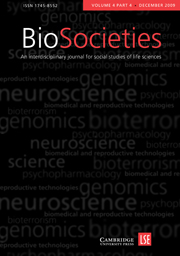Article contents
Beasting the Embryo: The Metrics of Humanness in the Transpecies Embryo Debate
Published online by Cambridge University Press: 01 September 2009
Abstract
The creation and use of transpecies human-animal embryos for research has figured prominently in recent highly controversial changes to UK reproductive legislation. This article reflects on the debate in the UK parliamentary context, drawing on socio-anthropological writing on hybridity. It seeks to make sense of two related cultural contradictions evident in the debate. First, a paradoxical position has been taken over decades in which the law simultaneously bans and yet permits the production of transpecies embryos. Second, key stakeholders have based their arguments on the simultaneous differentiation and dedifferentiation of embryos. Attempts to distinguish between different classes of embryo (cybrids, chimeras, pure hybrids, etc.) have been in tension with pressures to homogenize all embryos as morally equal. The article explores both of these contradictory tensions in the debate and their significance for the regulation and oversight of reproductive research.
- Type
- Articles
- Information
- Copyright
- Copyright © London School of Economics and Political Science 2009
References
- 16
- Cited by


